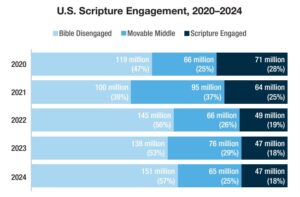
The growing Gen Z mental health crisis is being felt across the nation—in schools, families, and churches. The American Academy of Pediatrics, the Children’s Hospital Association, and the American Academy of Child and Adolescent Psychiatry recently declared this crisis a national emergency. As a pastor or church leader, you may have a unique opportunity to come alongside educators and parents to make a difference in the lives of young people struggling with mental health.
Springtide Research Institute recently released sobering findings on Gen Z (ages 13-25) mental health trends two years into COVID-19.
The research found teens and young adults feel extremely depressed, anxious, stressed, and lonely. Over half of young people (53%) reported the biggest challenge they faced during the pandemic was their mental health. Nearly half of young people (48%) say they’re moderately or extremely depressed. Another 1 in 4 say they’re extremely stressed (25%). And 1 in 5 say they’re extremely anxious (26%) or extremely lonely (21%). Worse, 6 in 10 young people (61%) say adults in their lives don’t truly know the extent of their struggles. This includes 59% of young Protestants.
These trends aren’t necessarily new. Experts have been monitoring America’s “loneliest” generation and their mental health since before the pandemic. Gen Z faces the normal challenges of typical adolescent uncertainty. But there’s really no “normal” for them to return to after the pandemic. Their worlds turned upside down just as they were starting to find their footing.
We can begin to understand these years of their lives are not opportunities and events delayed, like an adult returning to a well-known office at a steady job. In many instances, young people are missing entire developmental markers and moments—formative and singular events that in many cases cannot be easily made up for or replaced. And often, these losses are coupled and magnified by a loss of support systems, the kind that would normally help them move forward in times of uncertainty or growth. In essence, the pandemic hasn’t been a mere speed bump in their lives. It’s been a sudden and dramatic left turn.
Anyone who works with Gen Z is facing a mental health crisis in this generation at levels they’ve never seen before.
In Springtide’s new report, Mental Health & Gen Z: What Educators Need to Know, Springtide Executive Director, Dr. Josh Packard, unpacks a heavy burden both faith leaders and educators working with young people are familiar with.
“In the past decade, many teachers have been trained to spot the warning signs of mental-health crises in our students, direct them toward resources, and check in on them regularly—all while doing the thousands of other things that constitute our jobs,” Packard says. “But sometimes it doesn’t work. We don’t see. We’re too busy or too untrained or the situation is simply beyond our capacity to see and respond to.”
This typical approach—focusing on monitoring and, when needed, individual crisis intervention—is still critical work. But what if there are twice as many students falling into crisis? An already challenging task could easily become overwhelming. For a lot of churches, there simply aren’t enough trusted adults to meet the growing need. The answer, then, is to focus time and resources on building a mental health-friendly culture that goes beyond crisis response.
There are a number of actions faith leaders and communities can take to begin caring for young people in ways that mitigate mental health struggles before they become crises. Some of these are pragmatic—staying in touch, making referrals to mental health professionals, and offering financial help with counseling costs. While these pragmatic things are vital, the research shows young people need more.
A critical finding from Springtide’s mental health study is that young people who feel they belong in a community say they’re “flourishing a lot” in their mental health at significantly higher rates than those who don’t feel they belong. To be sure, belonging isn’t just a result of well-thought-out programs. It’s also a function of highly relational practices like knowing their name, acknowledging their presence and their absence, remembering details they’ve shared about their lives, and—especially for this generation—being cognizant and appreciative of their identities (e.g., racial or ethnic).
A 2020 Springtide report demonstrated a pattern in the stories of young people as they moved from initial joining to experiences of belonging. Three distinct feelings kept surfacing as they talked: feeling noticed, being named, and feeling known. This pattern resurfaced in interviews for this report. This pattern of moving from noticed to named to known is known as the Belongingness Process.
Young people initially enter relationships, groups, and organizations because of certain commonalities—shared interests, values, beliefs, practices, vocations, or professions. But they stay in those relationships when they feel like they belong. Pastors and church leaders should lead the way in cultivating a sense of belonging for young people.
Here are three action steps pastors can take to cultivate a stronger sense of belonging for young people at your church:
1. Look for outliers
Consider young people who are likely to not feel they are a part of your church community—perhaps minorities, those with reclusive personalities, or those attending inconsistently. Assess what you can do to help these students.
2. Consider assigning adult mentors to your students
Be it an elder or deacon, a staff member, or someone whose kids are grown, this adult can be someone students can connect with beyond typical church activities. These mentors don’t need to be trained mental-health practitioners, but they should be ready to listen and willing to help a student find the resources they need.
3. Offer mental-health first-aid awareness training to students
When it comes to conversations about mental health, young people naturally turn to one another. Therefore, the more peer connections they have, the better. But beyond this, you can equip young people with the skills to help one another. Students can be better equipped to help their friends and, importantly, to know when to bring a concern to a trusted adult. Mental Health First Aid is one organization offering this training.
Many churches are doing a good job helping Gen Z feel noticed, named, and known on a basic level. However, there are important places where pastors can strive to dig deeper into this dynamic and truly create a sense of belonging that leads to connection. Taking action dedicated to building connections at your youth group or college ministry is a sure way to create an environment that is mental-health friendly at its very core.
This article first appeared here.















